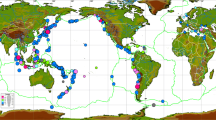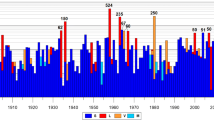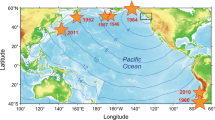Abstract
We report the result of a 2010 survey of the effects on the Iranian coastline of the tsunami which followed the earthquake of 27 November 1945 (M 0 = 2.8 × 1028 dyn cm; M w = 8.2), the only large event recorded along the Makran subduction zone since the onset of instrumental seismology. Based on the interview of elderly survivors of the event, we obtained a database of nine values of run-up or splash amplitudes on a segment of shore extending 280 km from Souraf in the West to Pasabandar near the Pakistani border, and ranging in vertical amplitude from 2.3 to 13.7 m. Witness reports are consistent with a significant delay (estimated at ~2.5 h) of the tsunami waves, suggesting that they were generated by an ancillary phenomenon, such as a landslide triggered by the earthquake. None of our witnesses bore ancestral memory of comparable events in the past, suggesting that reported predecessors to the 1945 earthquake may have been smaller in size. The survey also allowed the compilation of previously unreported data concerning the effects of the 2004 Sumatra–Andaman tsunami.







Similar content being viewed by others
References
Ambraseys, N.N., and Melville, C.P. (1982), A history of Persian earthquakes, Cambridge Univ. Press., Cambridge, 219 p.
Ando, M. (1975), Source mechanism and tectonic significance of historical earthquakes along the Nankai Trough, Japan, Tectonophysics, 27, 119–140.
Anonymous (2015), Remembering the 1945 Makran tsunami: Interviews of survivors beside the Arabian Sea, UNESCO − IOC Brochure 2015-1, 79 pp., Paris.
Arrian of Nicomedia (1983), Anabasis Alexandri, Books V–VII; Indica, ed. and transl. by P.A. Brunt, Harvard Univ. Press, Cambridge, Mass., 589 p.
Beer, A., and Stagg, J.M. (1946), Seismic sea-wave of November 27, 1945, Nature, 158, 63.
Bird, G.P. (2003), An updated digital model of plate boundaries, Geochem., Geophys. Geosyst., 4, (3), 1027, 52 pp.
Bouhadad, Y., Nour, A., Slimani, A., Laouami, N., and Belhai, D. (2004), The Boumerdes (Algeria) earthquake of May 21, 2003 (M w = 6. 8): Ground deformation and intensity, J. Seismol., 8, 497–506.
Byrne, D.E., Sykes, L.R., and Davis, D.M. (1992), Great thrust earthquakes and aseismic slip along the plate boundary of the Makran subduction zone, J. Geophys. Res., 97, 449–478.
Cisternas, M., Atwater, B.F., Torrejón, F., Sawai, Y., Machuca, G., Lagos, M., Eipert, A., Youlton, C., Salgado, I., Kamatabi, T., Shishikura, M., Rajendran, C.P., Malik, J.K., Rizal, Y., and Husni, M. (2005), Predecessors of the giant 1960 Chile earthquake, Nature, 437, 404–407.
Egbert, G.D., and Erofeeva, S.Y. (2002), Efficient inverse modeling of barotropic ocean tides, J. Atmos. Ocean. Tech., 19, 183–204.
El-Robrini, M., Gennesseaux, M., and Mauffret, A. (1985), Consequences of the El-Asnam earthquakes: Turbidity currents and slumps on the Algerian margin (Western Mediterranean), Geo-Marine Letts., 5, 171–176.
Engdahl, E.R., and Villaseñor, A. (2002), Global Seismicity: 1900–1999, In: International Handbook of Earthquake and Engineering Seismology, Part A, ed. by W.H.K. Lee, H. Kanamori, P.C. Jennings, and C. Kisslinger, Chapter 41, pp. 665–690, Academic Press, London.
Fritz, H.M., and Borrero, J.C. (2006), Somalia field survey of the 2004 Indian Ocean tsunami, Earthq. Spectra, 22, S219–S233.
Fritz, H.M., and Okal, E.A. (2008), Socotra Island, Yemen: Field survey of the 2004 Indian Ocean tsunami, Natural Haz., 46, 107–117.
Fritz, H.M., Blount, C.D., Albusaidi, F.B., and Al-Harthy, A.H.M. (2010), Cyclone Gonu storm surge in Oman, Estuar. Coastal Shelf Sci., 86, 102–106.
Gutenberg, B., and Richter, C.F. (1954), Seismicity of the Earth and Associated Phenomena, Princeton Univ. Press, Princeton, 310 p.
Heezen, B.C., and Ewing, W.M. (1952), Turbidity currents and submarine slumps, and the 1929 Grand Banks earthquake, Amer. J. Sci., 250, 849–878.
Heezen, B.C., and Ewing, W.M. (1955), Orléansville earthquake and turbidity currents, Bull. Amer. Soc. Petrol. Geol., 39, 2505–2514.
Heidarzadeh, M., and Satake, K. (2014), Possible sources of the tsunami observed in the Northwestern Indian Ocean following the 2013 September 24 M w = 7.7 Pakistan inland earthquake, Geophys. J. Intl., 199, 752–766.
Heidarzadeh, M., and Satake, K. (2015), New insights into the source of the Makran tsunami of 27 November 1945 from tsunami waveforms and coastal deformation data, Pure Appl. Geophys., 172, 621–640.
Houtz, R.E. (1962), The 1953 Suva earthquake and tsunami, Bull. Seismol. Soc. Amer., 52, 1–12.
Kagan, Y.Y. (1991), 3-D rotation of double-couple earthquake sources, Geophys. J. Intl., 106, 709–716.
Kakar, D.M., Naeem, G., Usman, A., and Atwater, B.F. (2015), The Balochistan and Sindh coast survivors revealed facts of the 1945 Makran tsunami, Proc. Intl. Conf. Reducing Tsunami Risk in Western Indian Oc., Muscat, Oman, UNESCO-IOC, Muscat (abstract).
Kelsey, H.M., Nelson, A.R., Hemphill-Haley, E., and Witter, R.C. (2005), Tsunami history of an Oregon coastal lake reveals a 4600-yr record for great earthquakes on the Cascadia subduction zone, Geol. Soc. Amer. Bull., 117, 1009–1032.
Kukowski, N., Schillhorn, T., Flueh, E.R., and Huhn, K. (2000), Newly identified strike-slip plate boundary in the Northeastern Arabian Sea, Geology, 28, 355–358.
Masson, F., Anvari, M., Djamour, Y., Walpersdorf, A., Tavakoli, F., Daignières, M., Nankali, H., and Van Gorp, S. (2007), Large-scale velocity field and strain tensor in Iran inferred from GPS measurements; new insight for the present-day deformation pattern within NE Iran, Geophys. J. Intl., 170, 436–440.
Mokhtari, M., Fard, I.A., and Hessami, K. (2008), Structural elements of the Makran region, Oman Sea, and their potential relevance to tsunamigenesis, Natural Hazards, 47, 185–199.
Musson, R.M.W. (2009), Subduction in the Western Makran: the historian’s contribution, J. Geol. Soc. London, 166, 387–391.
Nanayama, F., Satake, K., Furukawa, R., Shimokawa, K., Atwater, B.F., Shigeno, K., and Yamaki, S. (2003), Unusually large earthquakes inferred from tsunami deposits along the Kuril trench, Nature, 424, 660–663.
Neetu, S., Suresh, I., Shankar, R., Nagarajan, R., Sharma, R., Shenoi, S.S.C., Unnikrishnan, A.S., and Sundar, D. (2011), Trapped waves of the 27 November 1945 Makran tsunami: observations and numerical modeling, Natural Hazards, 59, 1609–1618.
Niazi, M., Shimamura, H., and Matsu’ura, M. (1980), Microearthquakes and crustal structure off the Makran coast of Iran, Geophys. Res. Letts., 7, 297–300.
Okal, E.A., and Reymond, D. (2003), The mechanism of the great Banda Sea earthquake of 01 February 1938: Applying the method of Preliminary Determination of Focal Mechanism to a historical event, Earth Planet. Sci. Letts., 216, 1–15.
Okal, E.A., and Synolakis, C.E. (2008), Far-field tsunami hazard from mega-thrust earthquakes in the Indian Ocean, Geophys. J. Intl., 172, 995–1015.
Okal, E.A., Synolakis, C.E., Fryer, G.J., Heinrich, P., Borrero, J.C., Ruscher, C., Arcas, D., Guille, G., and Rousseau, D. (2002), A field survey of the 1946 Aleutian tsunami in the far field, Seismol. Res. Letts., 73, 490–503, 2002.
Okal, E.A., Borrero, J.C., and Synolakis, C.E. (2006a), Evaluation of tsunami risk from regional earthquakes at Pisco, Peru, Bull. Seismol. Soc. Amer., 96, 1634–1648.
Okal, E.A., Fritz, H.M., Raveloson, R., Joelson, G., Pančošková, P., and Rambolamanana, G. (2006b), Madagascar field survey after the December 2004 Indian Ocean tsunami, Earthquake Spectra, 22, S263–S283.
Okal, E.A., Fritz, H.M., Raad, P.E., Synolakis, C.E., Al-Shijbi, Y., and Al-Saifi, M. (2006c), Oman field survey after the December 2004 Indian Ocean tsunami, Earthquake Spectra, 22, S203–S218.
Okal, E.A., Sladen, A., and Okal, E.A.-S. (2006d), Rodrigues, Mauritius and Réunion Islands field survey after the December 2004 Indian Ocean tsunami, Earthquake Spectra, 22, S241–S261.
Okal, E.A., Synolakis, C.E., Uslu, B., Kalligeris, N., and Voukouvalas, E. (2009a), The 1956 earthquake and tsunami in Amorgos, Greece, Geophys. J. Intl., 178, 1533–1554.
Okal, E.A., Fritz, H.M. and Sladen, A. (2009b), 2004 Sumatra tsunami surveys in the Comoro Islands and Tanzania and regional tsunami hazard from future Sumatra events, South Afr. J. Geol., 112, 343–358.
Oldham, R.D. (1893), A manual of the geology of India: stratigraphical and structural geology, Off. Superint. Gov. Printer, Calcutta, 543 p., 1893.
Pendse, C.G. (1946), The Mekran earthquake of the 28th November 1945, India Meteorol. Dept. Sci. Notes, 10, 141–146.
Quittmeyer, R.C., and Jacob, K.H. (1979), Historical and modern seismicity of Pakistan, Afghanistan, Northwestern India, and Southeastern Iran, Bull. Seismol. Soc. Amer., 69, 773–823.
Rajendran, C.P., Rajendran, K., Shah-hosseini, M., Naderi Beni, A., Nautiyal, C.M., and Andrews, R. (2013), The hazard potential of the Western segment of the Makran subduction zone, Northern Arabian Sea, Natural Hazards, 65, 219–239.
Repetti, W.C. (1934), The China Sea earthquake of February 14th, 1934, in: Seismological Bulletin for 1934 January-June, Dept. Agriculture and Commerce, Govt. of the Philippine Is., pp. 22–29, Manila.
Reymond, D., and Okal, E.A. (2000), Preliminary determination of focal mechanisms from the inversion of spectral amplitudes of mantle waves, Phys. Earth Planet. Inter., 121, 249–271.
Salaree, A., and Okal, E.A. (2015), Field survey and modeling of the Caspian Sea tsunami of 20 June 1990, Geophys. J. Intl., 201, 621–639.
Satake, K., Shimazaki, K., Tsuji Y., and Ueda, K. (1996) Time and size of a giant earthquake in Cascadia inferred from Japanese tsunami records of January 1700, Nature, 379, 246–249.
Sella, G.F., Dixon, T.H., and Mao, A. (2002), REVEL: A model for Recent plate velocities from space geodesy, J. Geophys. Res., 107, (B4), ETG_11, 32 p.
Shah-hosseini, M., Morhange, C., Naderi Beni, A., Marriner, N., Lahijani, H., Hamzeh, M.A., and Sabatier, F. (2011), Coastal boulders as evidence for high-energy waves on the Iranian coast of Makran, Mar. Geol., 290, 17–28.
Synolakis, C.E., Bardet, J.-P., Borrero, J.C., Davies, H.L., Okal, E.A., Silver, E.A., Sweet, S., and Tappin, D.R. (2002), The slump origin of the 1998 Papua New Guinea tsunami, Proc. Roy. Soc. (London), Ser. A, 458, 763–789.
The Times of India (1945a), Bombay, 29 and 30 November 1945a.
The Times of India (1945b), Bombay, 06 December 1945b.
Vernant, P., Nilforoushhan, F., Hatzfeld, D., Abbassi, M.R., Vigny, C., Masson, F., Nankali, H., Martinod, J., Ashtiani, A., Bayer, R., Tavakoli, F., and Chéry, J. (2004), Present-day crustal deformation and plate kinematics in the Middle East constrained by GPS measurements in Iran and Northern Oman, Geophys. J. Intl., 157, 381–398.
Walton, H.I. (1865), Correspondence, Trans. Bombay Geogr. Soc., 17, ccxxv–ccxxvi.
White, R.S., and Klitgord, K. (1976), Sediment deformation and plate tectonics in the Gulf of Oman, Earth Plan. Sci. Letts., 32, 199–209.
Wilson, A.T. (1930), Earthquakes in Persia, Bull. School Orient. Afr. Stud., 6, 103–131.
Wysession, M.E., Okal, E.A., and Miller, K.L. (1991) Intraplate seismicity of the Pacific Basin, 1913–1988, Pure Appl. Geophys., 135, 261–359.
Acknowledgments
This project was made possible by a grant from UNESCAP. In addition, we gratefully acknowledge the support of the Iranian National Institute for Oceanography, particularly its Director, Dr. Vahid Chegini, as well as Mr. Majid Naderi, Mr. Nima Kiani and Ms. Fahimeh Foroughi in Tehran. In Chabahar, we are grateful to the Staff of Research Station of INIO, in particular to our driver, who took a personal interest in the project, and provided translation from the Balochi language during our interviews. Finally, we thank all our witnesses for their eagerness to share with us the precious memories of their unique experience during the 1945 tsunami. The paper was improved by the comments of reviewers.
Author information
Authors and Affiliations
Corresponding author
About this article
Cite this article
Okal, E.A., Fritz, H.M., Hamzeh, M.A. et al. Field Survey of the 1945 Makran and 2004 Indian Ocean Tsunamis in Baluchistan, Iran. Pure Appl. Geophys. 172, 3343–3356 (2015). https://doi.org/10.1007/s00024-015-1157-z
Received:
Revised:
Accepted:
Published:
Issue Date:
DOI: https://doi.org/10.1007/s00024-015-1157-z




